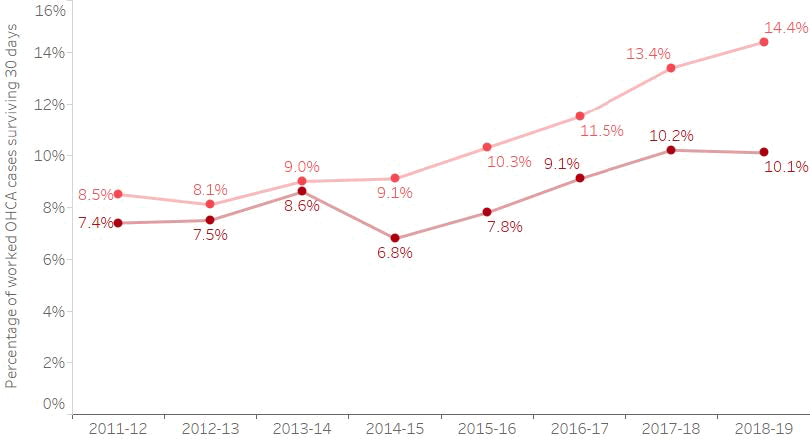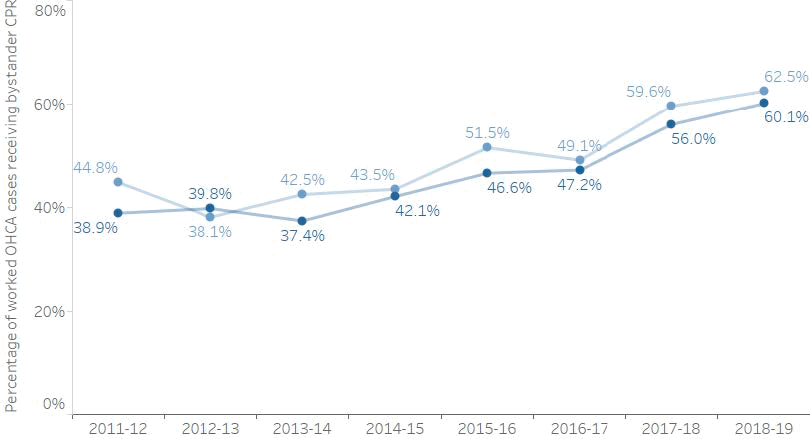Scottish Out-of-Hospital Cardiac Arrest data linkage project: 2018-2019 results
Report presenting the latest results of the Scottish out-of-hospital cardiac arrest data linkage project.
Scottish Index of Multiple Deprivation and OHCA
SIMD and 30-day survival
Analysis of Scottish OHCA outcomes has already shown that people living in more deprived areas are more likely to experience an OHCA and that patients from deprived areas are also less likely to survive following OHCA.
We have made a series of comparisons of OHCA survival between different groups using logistic regression techniques. This makes it possible to adjust for factors - for example age, sex and deprivation - that might differ between sub-groups and confound any associations. Logistic regression techniques adjust for these factors enabling us to make like-for-like comparisons.
Appendix 2 shows figures for occurrence of OHCA and mean patient age by SIMD quintile. In addition the unadjusted figures for percentages of 30 day survival, bystander CPR and shockable rhythm are also given.
Examining trends over time, the likelihood of 30 day survival is increasing for those living in all types of community in Scotland, however there has not been a significant change in the gap between outcomes in the most deprived communities compared to the least deprived areas. Comparing the likelihood of 30-day survival in quintiles 1 and 5 reveals that those patients living in the SIMD 1 (most deprived) are 30% more likely to die within 30 days of OHCA compared to those in SIMD 5 (least deprived), p=0.001. When adjusting for sex, age and urban/rural location, the effect of deprivation becomes stronger. With a like-for-like patient comparison, those living in areas of highest deprivation are 59% more likely to die within 30 days of OHCA compared to those in areas of lowest deprivation, p<0.001.
SIMD and bystander CPR
Deprivation also has a significant effect on the likelihood of receiving bystander CPR. As anticipated, the likelihood of receiving bystander CPR has improved with time in keeping with 30-day survival. Rates of bystander CPR have improved in all deprivation quintiles over time, however there still remains a significant difference between the least and most deprived quintiles. Those in the most deprived quintile are 12.6% less likely to receive bystander CPR compared to those in the least deprived areas. After adjusting for sex, age and urban/rural location the effect of deprivation becomes stronger. Those in the most deprived quintile are 19% less likely to receive bystander CPR compared to the least deprived quintile, p<0.001. Additionally those in SIMD 2 are 10% less likely to receive bystander CPR compared to those in SIMD 5, p=0.030. There is not a significant difference in likelihood of bystander CPR between those in SIMD 3 & 4 compared to the least deprived quintile, (p>0.05).
The tables in Appendix 2 show unadjusted figures for 30 day survival and bystander CPR comparing SIMD quintiles. SIMD 1 (most deprived) and SIMD 5 (least deprived) are compared below.
Figure 12: Percentage of worked OHCA cases surviving to 30 days, comparing SIMD 1 and SIMD 5 quintiles

Figure 12: Shows the percentage of worked cases surviving to 30 days by SIMD 1 (dark red) and SIMD 5 (light red) from 2011/12 to 2018/19. Note: these data include linked incidents only.
Figure 13: Percentage of worked OHCA cases receiving bystander CPR, comparing SIMD 1 and SIMD 5 quintiles

Figure 13: Shows the percentage of worked OHCA cases receiving bystander CPR by SIMD 1 (dark blue) and SIMD 5 (light blue) 2011/12 to 2018/19. Note: these data include linked incidents only.
Contact
Email: SWStat@gov.scot
There is a problem
Thanks for your feedback